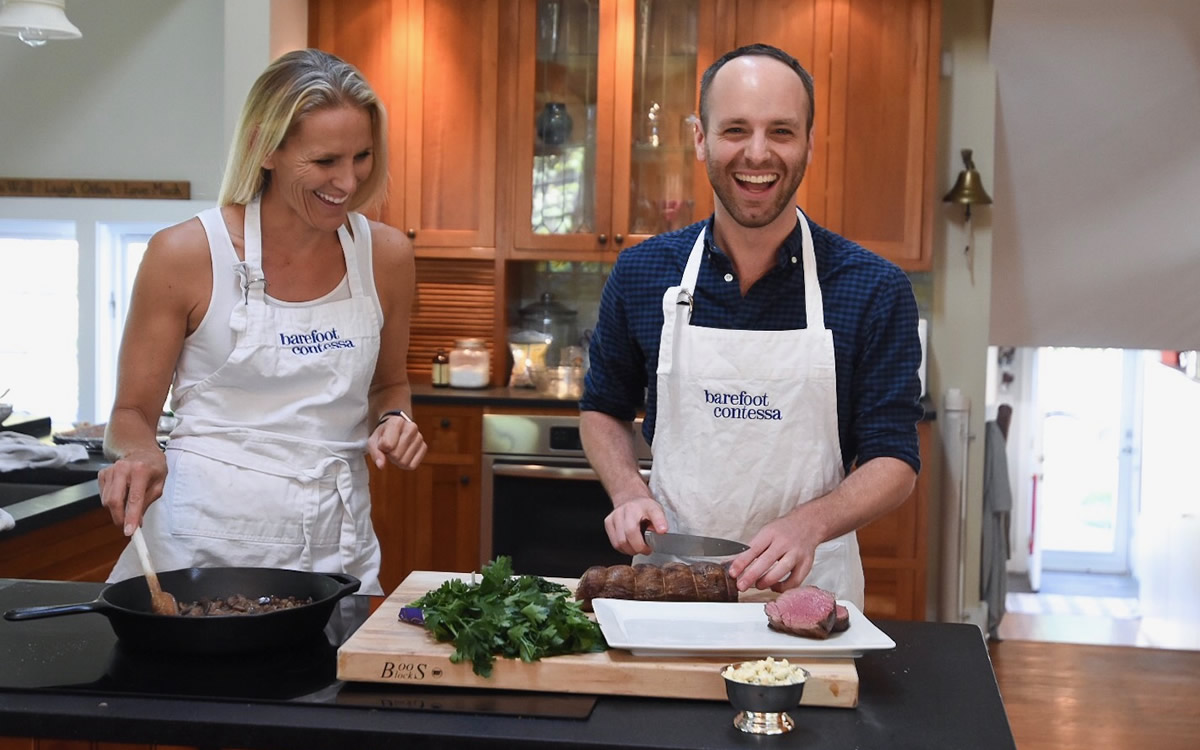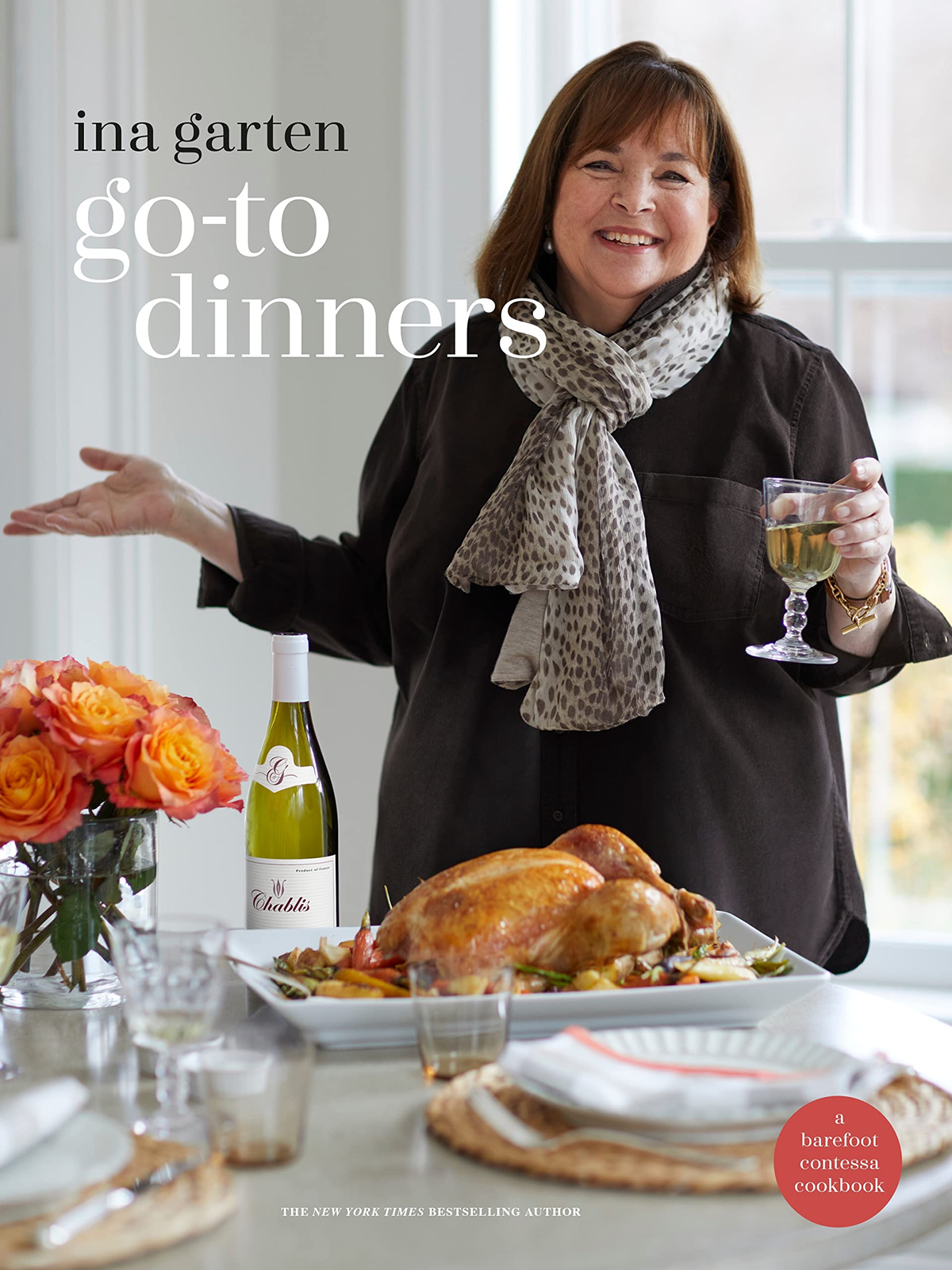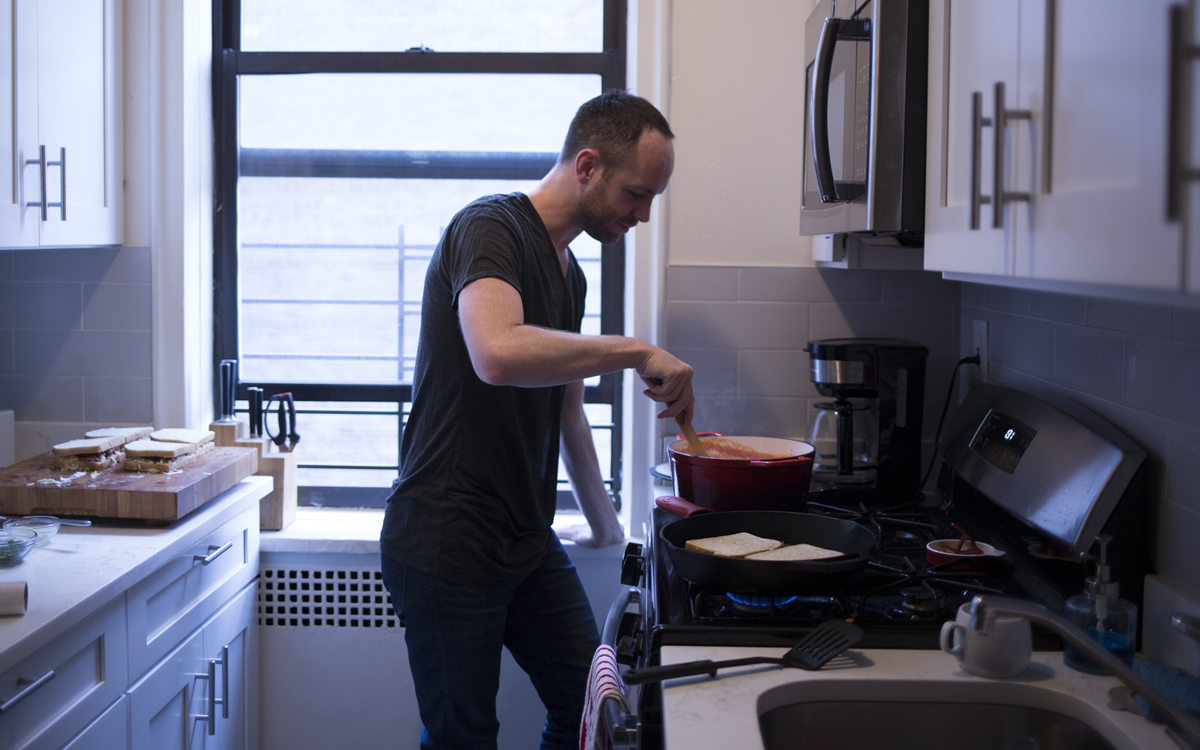Arts & Entertainment
Celebrating Ina Garten’s 13th cookbook with her biggest fan
Trent Pheifer has made all 1,272 of her recipes and counting

Ina Garten’s gay appeal is undeniable. From her fabulous home and gardens, to her creative cocktail recipes, to her many gay friends and over-the-top brunch parties, who wouldn’t want to count Ina as a friend?
He may not be on the brunch invitation list yet, but we can all live a bit vicariously through Trent Pheifer, 37, a home cook who chronicled his quest to cook all 1,272 of Garten’s recipes on Instagram (@storeboughtisfine), catching her eye and ultimately cooking with her on a Zoom event earlier this year.
To celebrate the release of Garten’s 13th cookbook this week, “Go-To Dinners,” the Blade sat down with Pheifer to talk all things Ina.
“She pulled me in, in a way that wasn’t about cooking,” Pheifer said. “She was always having a good time, it was approachable.”
Pheifer said that when he first started cooking he tried Julia Child, but ran into problems with her lengthy recipe for Beef Bourguignon.
“A lot of those recipes weren’t working out for me because I didn’t have the skills,” he said. “I had made a few of Ina’s recipes and everything was easy to read and gave me confidence in the kitchen and the results were delicious.”
Pheifer loved the film “Julie and Julia,” about a Julia Child fan who cooked all of the iconic chef’s recipes, and thought he would cook his way through Ina’s many recipes.
It took him nearly six and a half years, but he did it and in March of this year, he reached the end, culminating in a memorable Zoom event with Ina herself in which Pheifer cooked the final recipe, her Boston Cream Pie, a notoriously tricky dish.
What did he learn during all that time in the kitchen as an amateur cook?
“It’s about diving in — you just have to do it,” he says. “So many people think they aren’t good cooks because they’ve never cooked or they’ve tried something too complicated. … Don’t overdo it when getting started and slowly build.”
Pheifer noted that he was eating mostly prepared foods from Trader Joe’s when he started and now can make anything in Ina’s vast repertoire. But learning to cook isn’t all about impressing dinner guests with fancy dishes. Pheifer, who’s gay and works as a fundraiser for the Advertising Council in New York City, said the bigger lesson was discovering his self-confidence.

“I’ve always struggled with self-confidence — not being good enough or smart enough – and I think in the last seven years of this project my confidence has skyrocketed,” he said. “Having worked hard at something and being recognized, having fun with people, I found confidence in being myself and that has spilled over into my job and life. I wouldn’t be where I am without it.”
Pheifer also shared his thoughts on Ina’s appeal to gay men, noting that about half of his Instagram followers are men, most of whom he assumes are gay.
“A lot of gay men are attracted to strong women,” he said. “A lot of gay boys grew up with ‘Barefoot Contessa’ and a lot of her friends are gay and it’s a place you knew you were welcome. She never waved the Pride flag, but I knew I would be welcomed into her home.”
Aside from baking cookies with his mother and grandmother as a child, Pheifer didn’t grow up with an interest in the kitchen, though he noted the family sat down to dinner most nights together. By college he wasn’t cooking at all.
“When I was approaching 30 I realized I didn’t know how to cook for myself and it’s expensive to go out to dinner every day,” he said. Julia Child inspired him at first, until that run-in with the Beef Bourguignon. After discovering Ina’s recipes were more approachable, he only encountered one bad experience while cooking his way through her books: vegetable lasagna.
The recipe calls for roasting three trays of vegetables and making a sauce — not an easy feat in a small New York City kitchen. “There were too many elements at the same time,” he says.
Undeterred by the laborious lasagna recipe, Pheifer soldiered on for nearly seven years, sometimes wondering if all his efforts and Instagram posts would be noticed. He says he didn’t start the project hoping to get media attention, but there were thoughts that maybe all of this could lead somewhere.
“At some point you get years into the project and wonder, will anyone notice,” he said. “Ina is so beloved that she inspired this fan base of people who love her and I think I got lucky that no one else was doing it already.” He added that he didn’t do any outreach and the subsequent media attention was organic and came via word of mouth.
One highlight of Pheifer’s culinary journey came unexpectedly while on a vacation in Paris, which happens to be Ina Garten’s favorite city where she and husband Jeffrey own an apartment. He was on a foodie trip with friends and snagged a coveted table at Verjus, known for its tasting menu, when he spotted Ina and Jeffrey at a table in the intimate dining room. When they finished, Pheifer summoned the courage to approach his culinary idol.
“It was kismet,” he says, “the color ran from my face. I approached after they finished and my friend knocked over their bottle of wine as I was shaking their hands.”
He introduced himself as the man behind @storeboughtisfine and Ina immediately recognized him and they posed for a photo.
“I couldn’t think of a more magical way to meet her,” he said, “this was such an intimate experience and in the city she loves the most. Ina is obsessed with Paris so it was a magical moment.”
With Ina’s new book out Oct. 25, Pheifer says he will continue his quest to cook all of the recipes. He plans to tackle two or three each week.
And if Pheifer could pick the theme for Ina’s 14th cookbook, he says it would be “Store Bought is Fine.” Ina has said her next book will be a memoir and Pheifer hopes she will write about what drives her to create.
Although Pheifer turns to Ina for French, Italian, and American dishes, he said he collects all sorts of cookbooks and his favorite this year is “Korean American” by New York Times writer Eric Kim.
As for Pheifer’s favorite Ina recipe to make, he says it’s her rigatoni with sausage and fennel from “Cooking with Jeffrey.” Least favorite: pear and parsnip gratin. His go-to Ina dinner: Shrimp and Linguini Fra Diavolo with Outrageous Garlic Bread. Go-to dessert: Mocha Iced Box Cake. And his favorite Ina cookbook is “Barefoot Contessa At Home.”
Ina Garten’s latest, “Go-To Dinners” is out Oct. 25 from Clarkson Potter and includes breakfast-for-dinner options, make-ahead ideas, and simply assembled dishes.

The Blade may receive commissions from qualifying purchases made via this post.
Bars & Parties
Mixtape Sapphics hosts holiday party on Dec. 13
‘Sugar & Spice’ night planned for Saturday

Mixtape Sapphics will host “Sapphic Sugar & Spice: A Naughty-Nice Mixtape Holiday Party” on Saturday, Dec. 13 at 4 p.m. at Amsterdam Lounge.
This is a festive, grown holiday party for queer women and sapphics 35 and older at Revolt’s Christmas pop-up. There will be music, joy, and an optional White Elephant.
This is Mixtape Sapphics’ first-ever holiday party — a cozy, flirty, intentionally grounded night created just for queer women and sapphics 35+ who want real connection, festive joy, and a warm place to land at the end of the year.
Tickets start at $13.26 and can be purchased on Eventbrite.

Friday, December 12
“Center Aging Friday Tea Time” will be at 12 p.m. in person at the DC Center for the LGBT Community’s new location at 1827 Wiltberger St., N.W. To RSVP, visit the DC Center’s website or email [email protected].
Go Gay DC will host “LGBTQ+ Community Happy Hour” at 7 p.m. at Freddie’s Beach Bar and Restaurant. This event is ideal for making new friends, professional networking, idea-sharing, and community building. This event is free and more details are available on Eventbrite.
Women in Their Twenties and Thirties will be at 8 p.m. on Zoom. This is a social discussion group for queer women in the Washington, D.C. area. For more details, go to Facebook.
Saturday, December 13
Go Gay DC will host “LGBTQ+ Community Brunch” at 12 p.m. at Freddie’s Beach Bar & Restaurant. This fun weekly event brings the DMV area LGBTQ+ community, including allies, together for delicious food and conversation. Attendance is free and more details are available on Eventbrite.
The DC Center for the LGBT Community will host “Sunday Supper on Saturday” at 2 p.m. D.C.’s queer community will gather for good food, laughter, and community. For more information, email [email protected].
Sunday, December 14
SADBrunch will host “HokiSlay Drag Brunch” at 12 p.m. at Throw Social. This festive affair brings fierce performances, over-the-top holiday looks, and more sparkle than a tinsel explosion. Expect powerhouse lip-syncs, laughter, and cheer hotter than your spiked cocoa. Cake Pop will host the event. Tickets cost $28.52 and are available on Eventbrite.
Monday, December 15
“Center Aging: Monday Coffee Klatch” will be at 10 a.m. on Zoom. This is a social hour for older LGBTQ+ adults. Guests are encouraged to bring a beverage of choice. For more information, contact Adam ([email protected]).
Genderqueer DC will be at 7 p.m. on Zoom. This is a support group for people who identify outside of the gender binary, whether you’re bigender, agender, genderfluid, or just know that you’re not 100% cis. For more details, visit genderqueerdc.org or Facebook.
Tuesday, December 16
Center Bi+ Roundtable will be at 7 p.m. on Zoom. This is an opportunity for people to gather and discuss issues related to bisexuality or as Bi individuals in a private setting. Visit Facebook or Meetup for more information.
The DC Center for the LGBT Community will host “Self-Defense Class with Avi Rome” at 12:30 p.m. Rome is a proud member of the LGBTQ community and a full-time martial arts instructor with 25 years of teaching experience. He holds a Fifth Degree Black Belt in Jhoon Rhee Tae Kwon Do and is the director of the studio’s Adaptive Tae Kwon Do program for students with special needs. He has also run numerous self-defense workshops for various groups and situations. For more details, visit the center’s website.
Wednesday, December 17
Job Club will be at 6 p.m. on Zoom upon request. This is a weekly job support program to help job entrants and seekers, including the long-term unemployed, improve self-confidence, motivation, resilience and productivity for effective job searches and networking — allowing participants to move away from being merely “applicants” toward being “candidates.” For more information, email [email protected] or visit thedccenter.org/careers.
Asexual and Aromantic Group will be at 7 p.m. on Zoom. This is a space where people who are questioning this aspect of their identity or those who identify as asexual and/or aromantic can come together, share stories and experiences, and discuss various topics. For more details, email [email protected].
Thursday, December 18
The DC Center’s Fresh Produce Program will be held all day at the DC Center for the LGBT Community. People will be informed on Wednesday at 5 p.m. if they are picked to receive a produce box. No proof of residency or income is required. For more information, email [email protected] or call 202-682-2245.
Virtual Yoga Class will be at 7 p.m. on Zoom. This free weekly class is a combination of yoga, breath work and meditation that allows LGBTQ+ community members to continue their healing journey with somatic and mindfulness practices. For more details, visit the DC Center’s website.
Egypt
Iran, Egypt object to playing in Seattle World Cup ‘Pride Match’
Game to take place on June 26

Iran and Egypt have objected to playing in a “Pride Match” that will take place in Seattle during the 2026 World Cup.
The Egyptian Football Association on Tuesday said it told FIFA Secretary General Mattias Grafström in a letter that “it categorically rejects holding any activities related to supporting (homosexuality) during the match between the Egyptian national team and Iran, scheduled to be held in Seattle, USA, on June 26, 2026, in the third round of the group stage of the 2026 World Cup.” Football Federation Islamic Republic of Iran President Mehdi Taj told ISNA, a semi-official Iranian news agency that both his country and Egypt “protested this issue.”
The 2026 World Cup will take place in the U.S., Canada, and Mexico. The draw took place at the Kennedy Center on Dec. 5.
Iran is among the handful of countries in which consensual same-sex sexual relations remain punishable by death.
The State Department’s 2023 human rights report notes that while Egyptian law “did not explicitly criminalize consensual same-sex sexual activity, authorities regularly arrested and prosecuted LGBTQI+ persons on charges including ‘debauchery,’ prostitution, and ‘violating family values.’” Egyptian authorities “also reportedly prosecuted LGBTQI+ individuals for ‘misuse of social media.’”
“This resulted in de facto criminalization of same-sex conduct and identity,” notes the report.
The 2024 human rights report the State Department released earlier this year did not include LGBTQ-specific references.
Soccer has ‘unique power to unite people across borders, cultures, and beliefs’
The June 26 match between Iran and Egypt coincides with Seattle Pride. The Washington Post reported the Seattle FIFA World Cup 2026 Local Organizing Committee decided to hold the “Pride Match” before last week’s draw.
“As the Local Organizing Committee, SeattleFWC26’s role is to prepare our city to host the matches and manage the city experience outside of Seattle Stadium,” said SeattleFWC26 Vice President of Communications Hana Tadesse in a statement the committee sent to the Washington Blade on Wednesday. “SeattleFWC26 is moving forward as planned with our community programming outside the stadium during Pride weekend and throughout the tournament, partnering with LGBTQ+ leaders, artists, and business owners to elevate existing Pride celebrations across Washington.”
“Football has a unique power to unite people across borders, cultures, and beliefs,” added Tadeese. “The Pacific Northwest is home to one of the nation’s largest Iranian-American communities, a thriving Egyptian diaspora, and rich communities representing all nations we’re hosting in Seattle. We’re committed to ensuring all residents and visitors experience the warmth, respect, and dignity that defines our region.”
The 2034 World Cup will take place in Saudi Arabia.
Consensual same-sex sexual relations remain punishable by death in the country. The 2022 World Cup took place in neighboring Qatar, despite concerns over the country’s anti-LGBTQ rights record.
-

 Congress1 day ago
Congress1 day agoEXCLUSIVE: George Santos speaks out on prison, Trump pardon, and more
-

 Health4 days ago
Health4 days agoThe harsh truth about HIV phobia in gay dating
-

 Arts & Entertainment5 days ago
Arts & Entertainment5 days agoCynthia Erivo, Eva Victor, and ‘Blue Moon’ bring queer representation to Golden Globe film nominations
-

 Spain3 days ago
Spain3 days agoVictory Institute honors transgender Spanish senator in D.C.



















